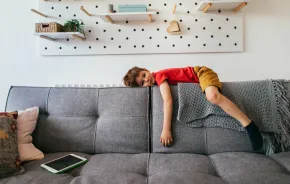They’re all around you: Messages about body image seem to bombard your daughter every day through the television set, the radio, the Internet, other kids — practically in the very air she breathes. “You must be waif thin!” “You must wear the latest fashion!” For many parents, addressing — let alone counteracting — all the stereotypes and consumerism is a daunting task.
 But parents and caregivers are far from helpless. We can control, or at least mitigate, media messages. We can keep that Cosmo under wraps, close the curtain on PG-13 teen love-fest movies and ban America’s Next Top Model. But experts say there’s one crucial, less obvious step: setting a good example. “I think parents can model a healthy lifestyle and mindful, non-judgmental living to their children,” says Kathleen B. Lustyk, Ph.D., a professor of psychology at Seattle Pacific University.
But parents and caregivers are far from helpless. We can control, or at least mitigate, media messages. We can keep that Cosmo under wraps, close the curtain on PG-13 teen love-fest movies and ban America’s Next Top Model. But experts say there’s one crucial, less obvious step: setting a good example. “I think parents can model a healthy lifestyle and mindful, non-judgmental living to their children,” says Kathleen B. Lustyk, Ph.D., a professor of psychology at Seattle Pacific University.
Research shows that parents play a crucial role in the area of a girl’s body dissatisfaction — both by making negative comments about their child’s appearance and by their attitudes toward their own bodies. In fact, one study, published in The International Journal of Eating Disorders, found that parents who say negative things about their own bodies have a major impact on their children’s beliefs about their own bodies, and this is true for both boys and girls.
The power of the positive
Jean Enersen, a mother and Emmy-winning news anchor at Seattle’s KING-TV , is acutely aware of the power of the positive parent. “Parents might not think their children are paying attention,” she says, “but with my kids raised now, I realize they are watching you, they really are listening to you, they are learning from you. So the behavior we model for them is very important. They watch how we carry ourselves, they watch what we eat, they watch how we exercise and listen to what we say.”
Friends matter, too, and Lustyk says parents should be aware of body messages that come through peers. “Given that research supports a predictive role of peers in the internalization of the thin body ideal, parents might wish to exercise their control over whom their child socializes with or in what settings.” Short of banning a thin-obsessed friend, for example, a mom who’s aware of a friend’s body obsession could help to thwart that negative message just by modeling a healthy, mindful and nonjudgmental attitude about her own body.
Keep 'em active
You’ve heard it before: Kids who participate in sports feel better about their bodies than kids who don’t. Sue Bird, point guard with the Seattle Storm women’s pro basketball team, says sports are the main reason for her positive body image and high self-esteem. “Becoming comfortable in your own skin allows you to not give in to social pressures,” such as those to smoke, drink and diet obsessively, she says. Myriad studies, including one by The President’s Council on Physical Fitness and Sports, find that athletically active girls have higher self-esteem, more confidence and a healthier body image than girls who don’t play sports. And according to the Women’s Sports Foundation, girls who participate in sports are less likely to become pregnant as teenagers and are less likely to suffer from depression.
Bird — like many child-development and health experts — believes that getting kids involved in sports is one of the best things parents can do for them. “It gets them with kids their own age; they’re working out, so that takes care of body image; it develops social skills and teamwork skills,” she says.
Enersen agrees. “I was very physically active, biking, tennis, swimming [as a child]. I think the focus on sports for girls is very healthful, as is a focus on how strong and physically capable you are.”
What’s at stake?
Dealing with body image in girls as young as 6 is certainly new territory for many parents. It used to be a problem of adolescence. But today it seems younger and younger girls are facing body image issues, and, as difficult as it is, parents and caregivers can’t afford to ignore it.
Lustyk says that depression is a real risk of a negative body image. In a 2006 study of 11-year-old girls, published in The Journal of Youth and Adolescence, researchers found that girls with more body dissatisfaction.
With the average model now a size 2, it’s never been more important for moms (and dads!) to dive into the fray and build up their little girls’ body images — something Bird says her mom did very well.
“My mom let me … wear whatever I wanted, even if it was ridiculous,” she says. Bird’s mom made her feel loved and supported, and really focused on the things that mattered most and not what she was wearing.
Karen Dawson, owner of Dawson Communications Group, is the mother of two boys, a former college basketball player and a firm believer in the importance of good role modeling.









